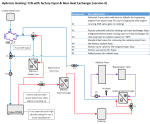Trying to get a hydronic system working in my conversion of a T1N sprinter van with factory espar auxiliary heater and rear passenger heat exchanger. Trying to get extend the system for the camper portion that would do the following:
Here's a quick schematic and a rough floorplan showing where the main components would sit:


I'm trying to also put together a parts list, and I'm hung up on the radiant loop pump (P2) and the isolating heat exchanger.
For the pump I'm thinking of just a simple automotive 12v aux pump (here's a link to the Bosch pump designed for VW/Audi I am considering: Bosch Water Pump).
The heat exchanger I know Espar makes a unit that comes with a thermostatic bypass valve already attached (Espar Plate Heat Exchanger).
Then I saw this unit on Amazon (Amazon Heat Exchanger) and thought I could probably just attach my own valve. But I'm wondering if that valve is your standard mixing valve or something else. If it's just a mixing valve, then I don't understand how it works. Every mixing valve I've seen is T shaped with the bottom of the T being the mixed output (always open) and the two sides of the T being the the hot/cold (selectively open)--which I can't see how that would work in this case where I'm just trying to bypass the heat exchanger altogether (see V3 in diagram above).
If it's not your standard mixing valve, can anyone point me the right direction for a "thermostatic bypass valve" or similar to what Espar has on their kit?
Also, regarding the expansion tank, what pressure should the cap be rated to? 12PSI?
Appreciate any feedback on the above, or any general feedback on the plan.
Cheers!
- Heat potable water for use in shower/sink/etc. via an Isotemp water tank (with integrated heat exchanger)
- Run radiant floor heat loop and through a undermount gray water tank
- Provide cabin heat through the factory rear heat exchanger and cab heater core
- Heating potable water, cabin, and floor while driving to destination
- Isolation of the engine from the camper heating loop to increase the efficiency of the system while camping
- Isolation of the radiant floor from the Isotemp loop for when I want hot water but not cabin heat
- Isolation of the camper from the engine heating/cooling loop for service/emergencies
- Isolate just the isotemp and radiant floor system to allow for the isotemp to be the heat source when I am connected to shore power in 3 seasons and only need a bit of heat at night but don't want to listen to the Espar kick on and off through the night. The Isotemp has a 750W heating element, so it wouldn't heat fast but it would be continuous.
Here's a quick schematic and a rough floorplan showing where the main components would sit:

I'm trying to also put together a parts list, and I'm hung up on the radiant loop pump (P2) and the isolating heat exchanger.
For the pump I'm thinking of just a simple automotive 12v aux pump (here's a link to the Bosch pump designed for VW/Audi I am considering: Bosch Water Pump).
The heat exchanger I know Espar makes a unit that comes with a thermostatic bypass valve already attached (Espar Plate Heat Exchanger).
Then I saw this unit on Amazon (Amazon Heat Exchanger) and thought I could probably just attach my own valve. But I'm wondering if that valve is your standard mixing valve or something else. If it's just a mixing valve, then I don't understand how it works. Every mixing valve I've seen is T shaped with the bottom of the T being the mixed output (always open) and the two sides of the T being the the hot/cold (selectively open)--which I can't see how that would work in this case where I'm just trying to bypass the heat exchanger altogether (see V3 in diagram above).
If it's not your standard mixing valve, can anyone point me the right direction for a "thermostatic bypass valve" or similar to what Espar has on their kit?
Also, regarding the expansion tank, what pressure should the cap be rated to? 12PSI?
Appreciate any feedback on the above, or any general feedback on the plan.
Cheers!
